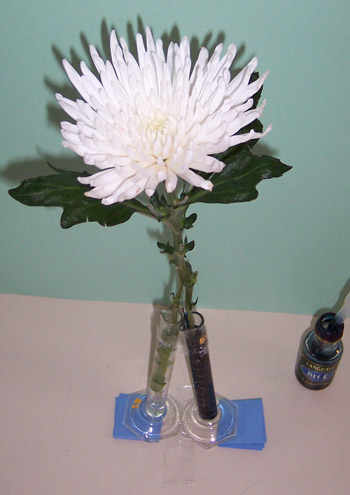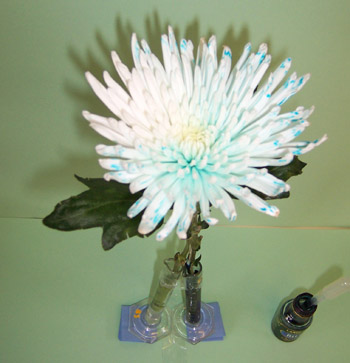Investigating transport systems in a flowering plant
Class practical or teacher demonstration
Cut the flower stalk of a white flower lengthwise. Place each segment of stalk in a different coloured dye, or in water. Predict how the colours might move up the stalk and into the flower. Leave for a few hours and observe the changes.
Lesson organisation
This could be carried out as a teacher demonstration, or with students working in small groups – formulating and testing their own hypotheses about the likely changes in the colour of the flower.
Apparatus and Chemicals
For each group of students:
Chrysanthemum or carnation, white, one per working group.
Measuring cylinders, 10 cm3, 2
Scalpel, 1 per working group
Tile (or other suitable cutting board)
Beaker, 100 cm3, to collect coloured water
Beaker, 100 cm3, to collect water
Plastic tray
Sticky tape
For the class – set up by technician/ teacher:
500cm3 of water with a food dye added to it. (Smaller volumes of water could be set up and a range of food dyes could be used.)
Health & Safety and Technical notes
Carry scalpels in a tray when moving around the laboratory. Always cut away from you and replace the scalpel in the tray when not in use.
Plant sap may be an irritant for some students.
Food dyes are low hazard.
1 This experiment could also be set up in test tubes or boiling tubes, which could then be supported in a rack or a larger beaker.
2 Taping the measuring cylinders to plastic trays reduces the risk of spills when moving the flowers.
3 It may be safer and waste fewer flowers if you cut the flower stalks for the students in advance.
Ethical issues
There are no ethical issues involved in using commercially produced cut flowers in this way.
Procedure
SAFETY: Carry and keep scalpels in a small tray. Wash hands after handling plants in case the sap is irritating to your skin.
Preparation
a Pre-cut the stalks if you feel it is necessary.
Investigation
b Take a white flower with a long stalk – for example, chrysanthemum or carnation. Cut the stalk carefully lengthwise; either all the way along the stalk to the base (or receptacle) of the flower or just part way up the stalk.
c Put each half of the stalk into a measuring cylinder (or boiling tube) containing either plain water or water to which food dye has been added.
d Wedges of paper underneath the measuring cylinders will tilt them towards one another and may make it easier to insert the stalks (see photographs).

e Tape the measuring cylinders to a plastic tray so that they don’t fall over.
f Leave the flower for a few hours (or overnight) and see where the dye ends up in the flower head.

Teaching notes
You can leave flowers for up to a week in large enough measuring cylinders, or if you can top up the water level.
If you use two food dyes you can get some interesting colour effects in the flower. If the flowers are cut only part way up the stalk, initially the flower will show two separate colours, but eventually the whole flower will show both dyes in all parts. Observe the plant each day (perhaps taking photographs) to see how quickly this change happens. This is because xylem vessels have openings along their length that allow water to move sideways between vessels.
This is useful when a xylem vessel develops an air lock, because water can move sideways into an adjacent xylem vessel and thus bypass the air lock. This is important in trees where bending in strong winds can cause the columns of water in xylem vessels to break. You can compare this with air locks in a central heating system or pipe where the air lock prevents water moving along the pipe. To limit lateral movement in the xylem vessels, cut the stalk right to the base/ receptacle of the flower. Discussion of air locks and sideways movement of water is most appropriate to advanced level studies.
These flowers make an interesting display for open days/ evenings. There are very few naturally-occurring large blue flowers, and you can make unusual combinations of colours. This is one way of producing unusual colours of flowers such as carnations or roses for parties or weddings.
Health & Safety checked, October 2008
Download a student sheet with questions and answers ![]() Investigating transport systems in a flowering plant (107 KB).
Investigating transport systems in a flowering plant (107 KB).
Related experiments
Measuring rate of water uptake by a plant shoot using a potometer
Estimating rate of transpiration from a plant cutting
Web links
www.plantscienceimages.org.uk
A database of images of plants including cross-sections through stems showing xylem vessels. A resources offered by SAPS – Science and Plants for Schools.
(Website accessed October 2011)


